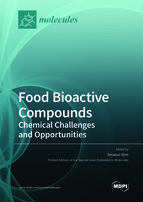Food Bioactive Compounds: Chemical Challenges and Opportunities
A special issue of Molecules (ISSN 1420-3049). This special issue belongs to the section "Cross-Field Chemistry".
Deadline for manuscript submissions: closed (31 December 2022) | Viewed by 69558
Special Issue Editor
Interests: Bioactive compounds; Analytical Chemistry; Food technology; Functional food properties; Bioinformatics
Special Issue Information
Dear Colleagues,
In recent years, there has been a growing need for both nutritional and healthy foods with superior functional properties. In this line, bioactive compounds are economically available in different foods systems with limitations in quality and functionality.
The present Special Issue is placed in this context, and aims to provide a collection of modern chemical strategies developed with the intent of extracting, characterizing, tracing, or authenticating food bioactive compounds. Original research articles dealing with innovative techniques for the extraction (e.g., green chemistry) of bioactive compounds are welcome. In addition, when discussing modern analytical methods, the structural characterization and identification of these active components is required. Attention will also be devoted to theoretical aspects of the determination of the bioactivity and mechanisms of action of food bioactive compounds as well as challenging properties for application as drug agents. Review articles providing an overview of the latest trends in this area of interest are also very welcome.
Dr. Smaoui Slim
Guest Editor
Manuscript Submission Information
Manuscripts should be submitted online at www.mdpi.com by registering and logging in to this website. Once you are registered, click here to go to the submission form. Manuscripts can be submitted until the deadline. All submissions that pass pre-check are peer-reviewed. Accepted papers will be published continuously in the journal (as soon as accepted) and will be listed together on the special issue website. Research articles, review articles as well as short communications are invited. For planned papers, a title and short abstract (about 100 words) can be sent to the Editorial Office for announcement on this website.
Submitted manuscripts should not have been published previously, nor be under consideration for publication elsewhere (except conference proceedings papers). All manuscripts are thoroughly refereed through a single-blind peer-review process. A guide for authors and other relevant information for submission of manuscripts is available on the Instructions for Authors page. Molecules is an international peer-reviewed open access semimonthly journal published by MDPI.
Please visit the Instructions for Authors page before submitting a manuscript. The Article Processing Charge (APC) for publication in this open access journal is 2700 CHF (Swiss Francs). Submitted papers should be well formatted and use good English. Authors may use MDPI's English editing service prior to publication or during author revisions.
Keywords
- bioactive compounds
- non-conventional extraction techniques
- modern analytical methods
- authenticity
- molecular mechanism
- functional properties







